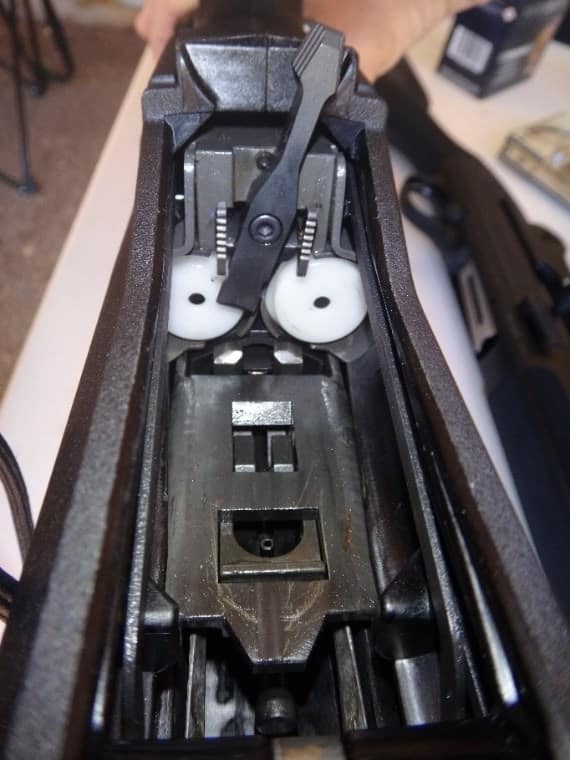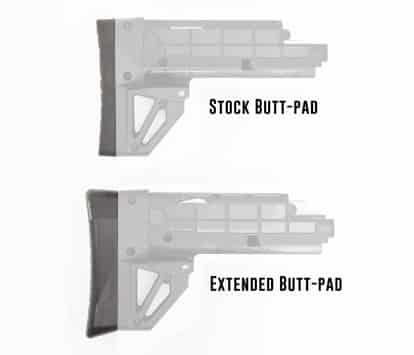
[nextpage title=”Page 1″ ]
Much has been written and said about this comparison. I wasn’t sure that more needed to be said or written about the subject since there are many outlets that have done this very comparison. However, I decided to do this a little differently. I wanted no influence from either manufacturer. So, I put my money where my mouth is and I bought these guns off the shelf with money I earned. Therefore, everything you’re about to see and read has not been influenced whatsoever from any manufacturer’s sources. Now, that is not to say that I’m influenced on any other day with any other gun or any gear I review, on the contrary, I write for you, the audience, hoping that I bring some integrity to the process. I hope that I am able to bring to you an unbiased opinion every time I write these reviews. Here’s something else that hopefully adds to my credibility; I’m not getting paid a single cent to write this article.
So, without boring you any further, let’s get to the comparison.
First off, let’s discuss why we’re even doing this review. There are many choices out there for home defense. I happen to think that shotguns, as a category, are the most versatile weapons available. There is a wide variety of ammo available, and many different types of shotguns. I think this bullpup design lends itself particularly well to the home defense purpose due to the light weight and shorter overall design of the weapon, and in the ability to outfit it with lights and sights of your choice (if you even really need a sight with a 12 gauge). The bullpup design allows the user to move tactically through a house if necessary without the problems of a really long barrel impeding your progress, or announcing your location prematurely. I also believe that since the shotgun has such a wide variety of ammo available, that in particular, these shotguns having two magazine tubes, allows the user to set up each tube with a specific type of ammo that can be chosen for use depending on the situation one might find themselves in. That, however, requires that the user put in many hours of practice with a particular weapon platform and thoroughly understand how the weapon works. Nothing beats practice and muscle memory in a high adrenaline situation. If you plan to buy one of these and simply load it, fire a few rounds through it and then prop it up behind your bedroom door, then I would not recommend loading it with more than one type of ammo. Taking that decision out of the stressful situation might save your life if you aren’t going to dedicate many hours of practice mastering either of these weapons platforms. I also chose these shotguns because of their popularity with the consumer, Hollywood and law enforcement, along with the fact that their unique design as a bullpup makes them stand out against the conventional shotgun design.
UTAS UTS-15
As mentioned above, this is a bullpup design shotgun made of polymer and steel. Most of the outside surfaces you will touch are made from polymer. It is chambered for 3” magnum shells and will run just about anything you feed it. The gun comes in a cardboard box. Included in the box is the well written and organized owner’s manual and a take-down tool.
The unit does not include sights from the factory, those must be purchased separately. There are a few other options that are offered with it. The laser/light combo is nice. It is integrated into the forend and the on/off switch is located above your index finger if you’re a “righty”, otherwise, “lefties” might have a more difficult time reaching the switch. It can also be outfitted with a Beretta style screw-in barrel extension, and a door-breach (UTAS calls it a ‘tactical’) choke. I did opt for the laser/light combo and am happy with the performance and ease of use. However, since the Kel-Tec does not offer this as an option, I am not, for the purposes of comparison, reviewing the use or utility of that part of the gun.
Loading the UTAS is a relatively easy process. There is a door on either side of the top. Flip the door down, then push the follower into the magazine and start feeding the shells in. It is a little deceptive, as the last shell actually stays in the port, it doesn’t get pushed into the magazine. It took me a little while to get used to that. Once the magazine tube is filled to the desired capacity, slapping the port door closed causes the plunger to apply pressure and set the shells up for feeding into the chamber. You can set the selector switch to feed from either tube, or leave it in the middle to feed from each tube. It will alternate back and forth automatically.
It was decided that the first shots should just be to get a feel for the way the gun handles and fires. We loaded it up with Federal target 2 3/4” shells. Reaching for the bolt release is somewhat awkward. It’s located on the bottom of the butt stock near the back of the stock. It is a smooth button that, with gloves on, is pretty hard to locate. Without gloves it’s a little more tactile, but still in an awkward location. Once depressed, you can then rack a round into the chamber through the normal/usual method. However, this usually leaves you with a round in the chamber and your strong hand nowhere near the trigger mechanism. Some have complained that the door covering the chamber is problematic since it is held in place with a magnet. To date I have experienced zero issues related to how that door and closure is designed.
Once you have your strong hand relocated back where it belongs on the grip, things get progressively better. For right-handers, the safety switch is easily manipulated with your strong hand thumb, rotating it into the fire position akin to an AR platform design. Since this gun does not ship with sights, I bought a Bushnell TRS-25 red dot site and mounted it atop the gun with a ½” riser on the built in top rail. Once set up properly, it is easy and quick to obtain a good sight picture.
Racking another round has to be deliberate. This shotgun does not suffer lazy people. If you don’t make a positive engagement to the rear stop of the forend, you will likely short-stroke the gun and fail to chamber the next round. Many complaints have been aired about this, but in my experience, I found that you just had to be deliberate, and it responded with a satisfying “bang” each and every time you rack a round. It ejects the spent shells out the right side and does a fair job of flinging them afar. For lefties, the right side ejection port may be an issue, but my friend is a lefty and he didn’t have any complaints about firing it and getting hot brass flung at him. Firing is predictable and smooth. The trigger is smooth and consistent all the way to the break point.
The UTS-15 magazine selector can be manually manipulated to block off either of the feed tubes. As mentioned previously, if you leave it centered, the gun automatically draws from both tubes, alternating automatically as it depletes the available ammunition.
The gun is easy to handle and manipulate overall, there wasn’t a huge learning curve aside from the gun demanding that you deliberately rack it. The weight of it (unloaded) is also an easy 6.9 pounds overall, so I didn’t feel it was heavy or sluggish to manipulate.
PROS:
- Bullpup design
- Optional integrated laser/light combo
- Lightweight
- Easy to load
- Shell count easily viewed through magazine ports
- Optional screw-in barrel extension
- Flip up top cover allows for easy failure clearing
- AR Style safety switch
- Easy single tool (included) field stripping
CONS:
- Expensive for a shotgun
- Poor location for bolt release
- Doesn’t come with the cool case made for it
- No sights included
- No place to hang a light if you don’t opt for the UTAS version
- Right side ejection port
- Controls are not ambidextrous
Click Next to Read the KSG Review.
[/nextpage]
[nextpage title=”Page 2″ ]
KSG
The KSG is polymer and steel construction with a bullpup design. The feed tubes are below the barrel, as opposed to the UTAS being located above the barrel. It is chambered for 3” magnum shells and will also run just about anything you feed it. The gun is sold in a cardboard box, which includes an owner’s manual, basic sling and sling strap retainer/tensioners.
Kel-Tec also offers an array of accessories for this model gun. Of note is the availability of a compensator and choke tube adapter. They have also addressed my three of my gripes about this gun, offering a kydex cheek rest, extended butt pad and a hand stop.

Again, I wanted to get a general feel for the gun and how it handled. We were firing the same Federal target loads. I loaded up the KSG, which I found to be a chore. The magazine tubes are located inside the ejection port and they load from the bottom of the gun. The only way to reliably get to them is to flip the gun upside down. Once in this position, the magazine ports are still at the bottom of the now exposed ejection port and not easy to see. The feed tube selector switch has to be pushed to the side in order for you to start filling one of the tubes up. If you install a longer selector switch, it’s going to impede loading as it will extend into the path you’re using to slide a shell into the magazine. Once that selected side is loaded, then it has to be manipulated again in order to start filling the opposite tube. This, to me, is not tactical reload friendly at all. In addition, there is a catch in there that tends to grab my finger every time I pushed a shell in. In the photo you can see them as the serrated shell stops oriented vertically. With gloves on, it’s almost a sure bet you’ll snag a fingertip on one of these eventually. I actually managed to stuff a round into the exposed chamber instead of the magazine tube when the slide was in the rear position. In Kel-Tec’s defense, the manual does say to ensure the forend has is locked forward to load. Overall, though, loading this thing takes more effort to load than I think is reasonable.
Once the task of loading is finished, it was time to throw some hate downrange. The bolt is easily released with the familiar small lever (ala Remington) on the front of the trigger guard. Press it down and rack it. Now you’re ready for business. The safety is a button located at the top of the pistol grip, roughly centered. It can only be engaged once a round has been chambered. So, if you start with the safety off, then rack a round, the gun is now hot with the safety off before the first round is fired. I personally don’t care for this, as the purpose of the safety is to prevent an AD, and this seems to me, is a situation that creates the very real possibility of an AD.
As with the UTAS, this gun does not include sights when sold. So, I mounted another Bushnell TRS-25 on this gun as well. The top rail on the KSG does not extend the full length of the gun. It begins at the end of the barrel and ends pretty close to even with the trigger assembly. For me, that puts this sight (and any flip-up rear sight) pretty far away from my ocular nerve, creating a very short sight radius if you’re utilizing iron sights and it’s not a natural feel when trying to utilize a site so far away from the view point. Not ideal, in my opinion. I also found that no matter how tight I tried to mount the TRS-25, it still rattled a little. I swapped it over to see if the mount was the problem. It wasn’t. For whatever reason, the top rail on the KSG would not allow me to tighten the sight down and take all the slack out of it.

It bears mentioning here that the out-of-the-box cheek rest is made of metal. “Good”, you say? Not on a cold morning. I put my face up against that thing and quickly recoiled. In moderate to cold temps, this gets cold soaked and it becomes very uncomfortable to press your face against (unless of course, you’re a full-on bearded operator seal sniper ranger). Me, I didn’t care for the experience. Pulling the trigger is smooth and predicable. The gun goes bang as advertised. I did not find the same short-stoke problem on this mechanism as I did with the UTS-15. What I did dislike, however, is the butt stock. It is narrow and short, concentrating a great deal of recoil energy into a very small contact patch with your shoulder. The butt-pad is only 4.5” tall X 2” wide X ¼” thick. This, to me, resulted in far more felt recoil than what I experience with the UTAS. As I write this, I’m still cringing. The UTAS, by comparison is 5” X 1 ½” X 1”. I think the thickness of the pad had more to do with the recoil absorption (or not) than the actual length and width, but it stands to reason that the smaller the contact area, the more concentrated the recoil power will be. The last few rounds I fired though it were painful and I really wanted to just put it down. I will admit that I was testing one other shotgun on this day (besides these two), so my shoulder was pretty well tenderized by the time I got to firing this. But, neither of the other two guns were as painful to fire as this was (the other was the Beretta 1301 Tactical) and I alternated through all three throughout the day. However, there is the optional extended butt-pad available from Kel-Tec for a mere $45. After shooting it, I would highly recommend getting something if not that, to help with recoil management. At this point, I’d settle for a wadded up towel.
Another unpleasant experience I had with this gun that I think is worth mentioning is that my strong hand wrist was peppered with hot exhaust and gun powder when firing. It was being splattered out the discharge port, where the spent shells drop out the bottom and where you load the gun. I experienced this mainly when firing the target rounds, but it still happened with less intensity with other types of ammo. I pulled on a pair of shooting gloves to try and cut it down some. They helped, but it was really my wrist that was taking the most abuse and the gloves didn’t help much in that area.
As I got going I heard a ‘click’ and no bang. I was initially a little puzzled at this, and proceeded to rack the gun again in an attempt to reload the chamber. No dice. I got another hollow ‘click’. I then realized that the first magazine was empty. There are small witness holes in the top of each magazine tube, but they aren’t readily visible with your head down firing. To select the other tube, you have to let go of the trigger and grip, and start hunting for the selector switch which slightly protrudes from the discharge port. Snap it over to the other side, then move your hand back into firing position. Once that procedure is completed, you now need to rack it again to chamber another round. I found that on two separate occasions while going through this, even after I racked what should have been the first round in the next tube, I still got a ‘click’ and had to rack it once more. In my opinion, if you are in a fire fight with people actively working on taking your life, this can induce a serious panic situation and might even cause you to throw down the weapon and reach for a handgun if you have one nearby provided you haven’t already been killed or seriously wounded by your attackers. Even if you do manage to get the next round ready to go, you’ve now racked the gun two to four times and had to let go of the bang switch to select the next tube. Again, not ideal in my world.
PROS:
- Bullpup design
- Feels short (26 inches in overall length)
- Lightweight
- Bolt release is in a great (familiar) place
- Integrated sling mounting points
- Easy field stripping
- Lower Picatinny rail
CONS:
- Short site radius
- Sights are a fair distance from the eye
- Metal cheek plate
- Manual magazine selector
- Must be flipped upside down to load
- Doesn’t come with the cool case made for it
- No sights included
- Finicky safety switch
- Not ambidextrous
- Stock looks adjustable, but it’s not
- Lower Picatinny rail is polymer
- No stop preventing your hand from slipping off into the line of fire!
- Kicks like a mule
- My wrist hurts
- Could not tighten up site on top rail
Click Next to read the Shot Tests and Conclusions.
[/nextpage]
[nextpage title=”Page 2″ ]
Shot Tests
The first rounds we used were those I mentioned above, the Federal target loads. Our second shot tests were with Federal Personal Defense buckshot. These are 2 ¾” shells filled with 34 #4 copper plated buckshot with a muzzle velocity of 1,100 FPS. These proved to be reliable and accurate in both guns. Felt recoil was about the same as what I experienced with the target shells. Finally, we used Herter’s 1 ounce slugs to see how they’d fare. Both guns did an excellent job handling the heavy lead and were spot-on accurate. In the photos you’ll likely notice that the KSG’s slug shots hit low and left. That is not a fault of the shotgun. That was due to the TRS-25 red dot not being correctly sighted for center. What you should notice is that the shot group is good, even though I experienced a little muzzle rise. That was mostly due to my not wanting to take the pain in my shoulder much more, otherwise the shots would have been much tighter from a shooting bench. Those same slugs being shot from the UTAS were in a much tighter group because I was able to control the muzzle better since I wasn’t being assaulted by the recoil nearly as much.
Even though the UTAS demands that you not short stroke it in order to rack the next round, I found that my learning curve to master that task was pretty fast. By the second magazine I had it down. In my opinion, this isn’t the real problem that a lot of people have made it out to be. It just takes getting used to a different weapons platform. The KSG however, no matter how many times I shot it, I never really learned to anticipate the last round in a magazine before the gun went click and required the tube selector switch to be manipulated. For me, that becomes a deal breaker. I don’t want to have to spend so much time getting used to a weapons platform that I have to compensate for its shortcomings. To me, the Kel-Tec just feels unfinished.
Despite my personal beliefs, I wanted to still give the Kel-Tec a fair assessment. We put the same rounds downrange at the same distances in both guns.
BUCKSHOT TESTS
Federal Premium Home Defense Buckshot:
I wanted to get a realistic pattern from 10 yards with ammo you would use to protect your home with. The UTAS and KSG both fired a decent, tight-ish pattern at that distance because the shells are loaded with pellets, the pattern was probably close to 13” in diameter, but 99% of those pellets hit the silhouette of the target. The KSG hit slightly left, but that again, is more of a problem with the red dot not being completely sighted in than the bore being out of alignment. It patterned just as effectively as the UTS-15 did. The Federal ammo is a winner, it showed great predictability in either gun, and both guns ran through round after round trouble-free.
1” SLUG TESTS
Next I wanted to use 1” slugs. I used some Herter’s 1 ounce slugs for these tests. These are 2 ¾” shells with rifled slugs having a muzzle velocity of 1,400 fps. Firing these from both guns there was more felt recoil. As before, it was especially pronounced with the KSG. Both guns ran through them without an issue. Again, the low-left-ish pattern of the KSG is not a fault of the gun, it was the red dot’s alignment.
Both shot the slugs very well with not issues at all. Both are effectively lethal loaded with slugs at a distance of 10 yards we were using.
CONCLUSIONS
Both of these guns are effective home defense platforms. Both are going to require that the user spend some quality range time making sure he or she is familiar with the controls and loading, as well as ensuring you’re familiar with the way the gun handles.
For me, there is a clear winner. The UTAS. IT was simply made better through the design process. The KSG asks the buyer to invest roughly the same money, but then to make the gun work as it should have from the factory, the user needs to add on a butt-pad, cheek rest, hand stop and be somewhat gentle with the lower rail. I don’t know about you, but in my opinion, these things should have already been considered and designed into the gun before it ever left the testing phase. It took me about 10 shots to know that the butt-pad was insufficient, and 1 cold day to see that the cheek rest was lacking (freezing). So, I don’t know what Kel-Tec’s defense might be for these items, but I stand by my comments here. The UTAS on the other hand is very demanding while being fired/racked. Then there’s the rattling sling mounts (which stop rattling if you take them off or mount a sling and the bolt release button. I hate that bolt release button on the UTAS. It’s in a terrible place and you have to hunt for it.
I really wanted to like the KSG. It looks great, it’s short, and best of all it’s made in the U.S.A. It just falls short of the mark. I can only describe it as, unfinished. So, there you have it. In my humble opinion, the UTAS wins hands down. I have a slightly used KSG for sale…
[/nextpage]













